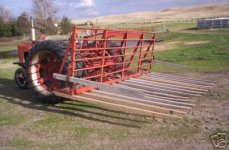Egon
Epic Contributor
The picture comes from a previous post on this sight by another fellow. I just saved it.
We used to call them farmhands Too.
The hay was made into a stack on the field. Many people had stack movers to bring the stack back to the feeding area. When feeding they used a pipe fence that was movable so the hay did not have to be handled.
Other people made smaller stacks, put them on a stackmover that had a sickle bar cutter on the front and would dispense the daily required feed by driving and cutting off hay from the end of the stack and into a trough or just on the ground.
But all this does not help the original poster with fixing his machine. /forums/images/graemlins/frown.gif
Egon
We used to call them farmhands Too.
The hay was made into a stack on the field. Many people had stack movers to bring the stack back to the feeding area. When feeding they used a pipe fence that was movable so the hay did not have to be handled.
Other people made smaller stacks, put them on a stackmover that had a sickle bar cutter on the front and would dispense the daily required feed by driving and cutting off hay from the end of the stack and into a trough or just on the ground.
But all this does not help the original poster with fixing his machine. /forums/images/graemlins/frown.gif
Egon

